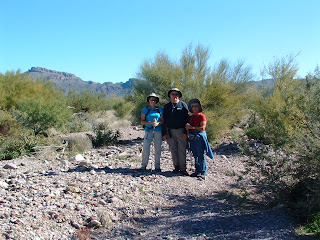Monday Sherri and I set off to finish a hike we attempted after we first arrived at Organ Pipe. The weather was much better this past Monday than the first time we tried to hike to the arches. Our goal is to reach the top of the arches.
Coming up the back side of this ridge is very steep and a lot of loose rock. We did make it up to the top, just to the right of the moon. Sherri is coming straight up.
Great views at the top; the road and parking lot are below.
Just down the road from the arches an employee had told me where to find petroglyphs, so Sherri and I took another hike and found the rock art. Pretty Cool!!
Tuesday morning I was a late addition going out to Bates Well to put the pronghorn fence back up. It was taken down last week to release five males. Two Natural Resources employees, Amy and Ed, are trying to find the released males on radar.
To get to Bates Well we went through an area closed to the public, there is an old ranch house along the road. Armenta Ranch is on the northern edge of the monument.
The pronghorn enclosure is in an open area and not much to look at. We put the 300' of fence back up in a couple of hours and took a tour of the ranch at Bates Well. This house is the last occupied "private residence" on the monument. Bobby Gray lived here until 1976.
Wednesday brought another hike up the old road between Ajo and Sonoyta, Mexico with a couple of other interps, Brian and Hilda. The hike is a mainly flat nine miles. There is a very interesting Christate on a saguaro cactus, we all thought it looked like a camel.
Thursday was a big day. We were up at 3:30am to drive with three other volunteers to the 640ac breeding pen for pronghorn. A few years ago there were only 22 Sonoran Pronghorn in existance, today the numbers are up to 250, but still very much an endangered species. Five males had been transfered to Bates Well pens and released. Today the hope was to transfer up to eight pregnant females to Bates Well. This is accomplished by first herding the pronghorn into holding pens, called bomas. Then the pronghorn to be transferred are sectioned off in the boma. To capture the pronghorn eight people holding a net go into the boma and the pronghorn is wrestled to the ground and the veterinarian gives the pronghorn a shot of anesthesia. The pronghorn then is brought out on a stretcher and is processed.
The big concern is the pronghorn overheat from stress. The vet closely monitors the animal while water is poured on the pronghorn, that is why we started at dawn. From the processing station the pronghorn are loaded on the back of a pickup and driven to the helicopter a half mile down the road. Here is Sherri holding the IV bag getting ready to go to the helicopter, the man in the hoodie holding the pronghorn's head is Lee Baiza, superintendent of Organ Pipe.
It is an incredible operation which we felt very honored to be a part of, unfortunately two of the four died before being transported....very sad. The thought was a change in the anesthesia cocktail was causing the problem. Friday they were able to transport four more successfully, so the hope is six pregnant pronghorns can be released into the wild. We will be involved some more in this program when we go out to Bates Well again to monitor the released animals.
The interpretive programs started today and Thursday is the start of our presentations; it is almost show time so we better be ready.












What wonderful experiences you are having!!! Thanks so much for sharing them with us. Great Photos and beautiful views of the landscape!!
ReplyDeleteWow this is a great blog! Love the arches and the hike. Great Saguaro. So sorry to hear about the pronghorn losses. Hope the program is successful.
ReplyDeleteWish I could come to one of your programs. I know they will be GREAT!